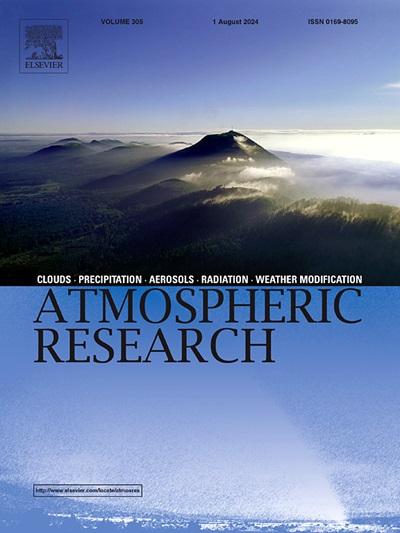Broadband VHF lightning radiation sources localization by ESPRIT algorithm
IF 4.5
2区 地球科学
Q1 METEOROLOGY & ATMOSPHERIC SCIENCES
引用次数: 0
Abstract
Fast and fine radiation source localization algorithm is of vital importance to lightning warning and protection. Current high-accuracy localization techniques, such as the time reversal technique (TR) and the multiple signal classification (MUSIC), are based on traversal search mechanism, which takes a long time. In this paper, the estimation of signal parameters via rotational invariance technique (ESPRIT) is applied to lightning radiation source localization, and the direction of arrival (DOA) can be directly solved through the covariance matrix, so it is very efficient. For the broadband VHF signal, the incoherent signal method (ISM) is combined with ESPRIT. Two classical structures of uniform -shaped array and uniform circular array are studied and applied to ESPRIT algorithm. As for the uniform circular array, the fourth order cumulant matrix is constructed to find the translation invariant subarrays. To unwrap the phase ambiguity caused by the calculated phase angle of ESPRIT algorithm, the total least difference of slope (TLDS) principle is proposed. The proposed ESPRIT algorithm is more than 1400 times faster than MUSIC while its localization accuracy is still pretty high, which is able to detect the radiation source under -8 dB signal to noise ratio (SNR) according to the result of numerical simulations, and can map continuous and fine lightning development channel in the experiments on the measured lightning data.
基于ESPRIT算法的宽带甚高频雷电辐射源定位
快速、精细的辐射源定位算法对雷电预警和防护至关重要。目前的高精度定位技术,如时间反转技术(TR)和多信号分类技术(MUSIC),都是基于遍历搜索机制,耗时较长。本文将旋转不变性技术(ESPRIT)信号参数估计方法应用于雷电辐射源定位,通过协方差矩阵直接求解到达方向(DOA),具有很高的效率。对于宽带甚高频信号,将非相干信号法(ISM)与ESPRIT相结合。研究了均匀l型阵列和均匀圆形阵列两种经典结构,并将其应用于ESPRIT算法。对于均匀圆形阵列,构造四阶累积矩阵求平移不变子阵列。为了消除ESPRIT算法计算相位角导致的相位模糊,提出了总最小斜率差(TLDS)原理。本文提出的ESPRIT算法在定位精度仍然很高的情况下,比MUSIC算法快1400倍以上,能够根据数值模拟结果检测到-8 dB信噪比(SNR)以下的辐射源,并能在实测闪电数据上绘制出实验中连续精细的闪电发展通道。
本文章由计算机程序翻译,如有差异,请以英文原文为准。
求助全文
约1分钟内获得全文
求助全文
来源期刊

Atmospheric Research
地学-气象与大气科学
CiteScore
9.40
自引率
10.90%
发文量
460
审稿时长
47 days
期刊介绍:
The journal publishes scientific papers (research papers, review articles, letters and notes) dealing with the part of the atmosphere where meteorological events occur. Attention is given to all processes extending from the earth surface to the tropopause, but special emphasis continues to be devoted to the physics of clouds, mesoscale meteorology and air pollution, i.e. atmospheric aerosols; microphysical processes; cloud dynamics and thermodynamics; numerical simulation, climatology, climate change and weather modification.
 求助内容:
求助内容: 应助结果提醒方式:
应助结果提醒方式:


